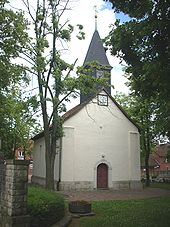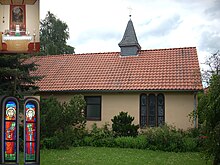Evern
|
Evern
City Sehnde
|
|
|---|---|
| Coordinates: 52 ° 19 ′ 1 ″ N , 10 ° 1 ′ 25 ″ E | |
| Height : | 76 m above sea level NN |
| Area : | 6.61 km² |
| Residents : | 542 (Dec 2018) |
| Population density : | 82 inhabitants / km² |
| Incorporation : | March 1, 1974 |
| Postal code : | 31319 |
| Area code : | 05138 |
|
The location of Evern in the urban area of Sehnde
|
|
Evern is a district of the city of Sehnde , southeast of Hanover . The oldest surviving document that mentions Evern is from 1117.
geography
Evern is part of the town of Sehnde in the Hanover region of Lower Saxony and has as neighboring towns:
- in the north Lehrte ,
- in the east Dolgen and Haimar ,
- in the south Klein Lobke as well
- in the west of Rethmar .
The Mittelland Canal runs south of the village . Evern is connected to the long-distance network via Bundesstraße 65 . The Schuttellobeke desert lies between Evern and the southern Klein Lobke . Evern is located in the historic settlement area of the Great Free .
Like its neighboring village Dolgen , Evern is located on an old moraine at least 70 m high . This ridge can be seen very well when coming from the direction of Lehrte.
history
The name of the place went from the name Eberen in 1117 to Everinge (1230), Everen (1313), Evern (1362), Everen (1400) and Euern (1558) to Evern in 1651 (the spelling u or v was added not fixed in time).
Renowned place name researchers consider interpretations with the reference to relationships to old words for water, for bank, for behind or later or for higher possible, which corresponds to the topographical location to the surrounding villages.
Evern was a typical old Saxon village until a devastating fire in 1825 . Finds from the Bronze Age on the nearby Leierberg testify to a very early settlement.
With generous donations to the diocese of Hildesheim , the Count of Haimar was able to acquire church rights for Evern on May 11, 1117. It is the oldest documented church law in the current city of Sehnde.
In 1386 the whole place was sold by the Counts of Saldern to the Hildesheim Cathedral Chapter.
After the Hildesheim collegiate feud , this circumstance often led to court-related disputes over competence between the Guelph sovereigns and the Hildesheim local lords. Only a settlement made in 1621 regulated the competences of the free court Evern. This later "civil and criminal court" has been documented since 1562 and was only officially dissolved on November 9, 1813. The original seal is in the possession of the Cologne City Museum.
The people of Evern were happy to take advantage of these disputes. So it happened that the bells for the death of the Lüneburg rulers were refused or at the beginning of the Reformation no residents of Evern took part in the evangelical service. They preferred to take the "Hilligenweg", which begins at the southeast of the village, to the diocese of Hildesheim to attend the Catholic service.
On June 15, 1825, almost the entire village was devastated by fire. In the evening hours the fire spread, probably from a homestead in the northeast of the village. Due to a dry period of nine weeks, the fire was able to eat its way very quickly through the old thatched roof village, aided by a strong easterly wind. Of the 57 houses and homesteads, only 16 remained intact. 278 residents were left homeless overnight.
At the end of 1826, the rebuilding of Evern was almost complete. The newly built houses and courtyards had to have a minimum distance to the neighbors; the road layout was generously redesigned. In order to create the necessary space in the village, some residents had to give up their traditional land. Their houses and farms were moved to the western edge of the place. The surveyor appointed by the Ilten office had the task of determining the new layout of the property. Sometimes this happened in protest of the villagers.
In the second half of the 19th century, the land consolidation of the Feldmark was carried out under the direction of the Otto Haarstrich economic council. The average land ownership of the farmers tripled through the reclamation of the area of the former Steinwedeler Forest. The roads leading to the neighboring towns were relocated on partly new routes through the center of the district. The streets in the village were cobblestone. In memory of Otto Haarstrich, a monument was erected on today's fire station.
On August 31, 1898 Evern was connected to the electrified overland tram network . From then on, the tram ran from the neighboring town of Haimar via Evern to Hanover . The place owed not only fast transport connections to this fact, but also an early supply of electrical power. In addition to passenger transport, rail freight transport was also a huge step forward at the time. A siding was laid at today's fire station especially for cargo handling. The tram line was replaced by a bus service in 1935. Except for some road changes and the settlements in southern Eichenkamp (1960s) and at the sports field (1980s), Evern received its present-day appearance in the 19th century.
On March 1, 1974 Evern was incorporated into the municipality, now the city of Sehnde.
religion
The Protestant St. George's Chapel from the 19th century is located in Evern . In its place there was also the first chapel of the parish that was established at the beginning of the 12th century. Some pastors justify their choice of this place because of a special spiritual meaning in pre-Christian times. Initially, the neighboring towns of Haimar, Dolgen and Gilgen were parish off to Evern, and in 1160 the parish seat was moved to Haimar.
On Easter Monday 1955 the Catholic St. Magdalenen Chapel was consecrated (Rethmarsche Straße 9), a solid building with a roof turret , which was built and equipped by people displaced from the East on their own. The property was donated by the Achilles family. Until now, the local Catholic services have been held in their manor house. The chapel belonged to the parish of St. Maria in Sehnde. On September 12, 2010, the chapel was profaned by Vicar General Werner Schreer , so that there are no more church services.
The chapel has been sold and will be converted into a residential loft.
politics
Until the municipal reform in 1974, Evern was an independent municipality. Today it is part of the city of Sehnde. Like almost all localities of the Great Free (Harber was already assigned to the Peine district in the 1960s), Evern also belonged to the former Burgdorf district . In the 1960s there were efforts to unite with the neighboring towns of Rethmar, Dolgen, Haimar and Harber to form a single community. Ultimately, however, the municipal reform left no other choice; the localities would never have reached the minimum population of 6000. The establishment of a joint congregation failed.
Today Evern forms a joint local council with Dolgen and Haimar, local mayor is Konrad Haarstrich ( CDU ).
Culture and sights
literature
Werner Walkling, Hanover: Haimar family book, places Haimar, Evern and Dolgen, 660 pages, softcover, self-published, Hanover, 2014
Tour de Eberen 900 years of Evern 1117–2017
Our home church Pastor Garbe
Web links
Individual evidence
- ↑ a b FIGURES - DATA - FACTS. www.sehnde.de, accessed on July 11, 2019 .
- ^ Federal Statistical Office (ed.): Historical municipality directory for the Federal Republic of Germany. Name, border and key number changes in municipalities, counties and administrative districts from May 27, 1970 to December 31, 1982 . W. Kohlhammer GmbH, Stuttgart and Mainz 1983, ISBN 3-17-003263-1 , p. 223 .
- ^ Local councilor Dolgen-Evern-Haimar



